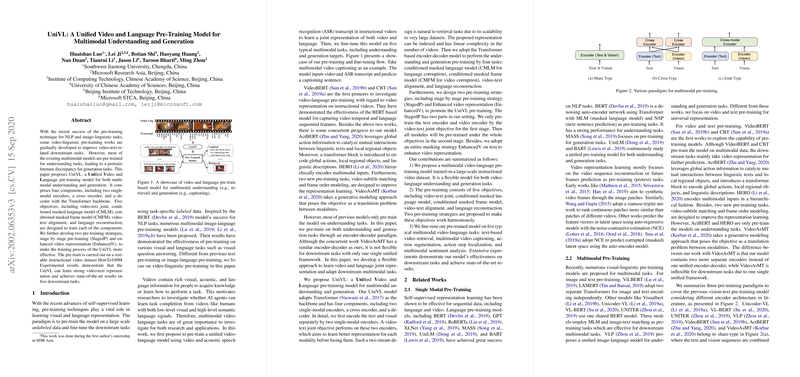An Overview of "UniVL: A Unified Video and Language Pre-Training Model for Multimodal Understanding and Generation"
The paper, "UniVL: A Unified Video and Language Pre-Training Model for Multimodal Understanding and Generation," presents a comprehensive approach aimed at bridging the gap between multimodal data understanding and generation tasks using a unified model architecture. This research paper focuses on a significant challenge in pre-training models for video-linguistic tasks: the pretrain-finetune discrepancy often observed when models pre-trained for understanding are fine-tuned for generation.
Model Architecture and Pre-Training Objectives
The proposed model, UniVL, is structured into four integral components: two single-modal encoders (text and video), a cross encoder, and a decoder, all pivoting on the Transformer architecture. This architecture targets multimodal tasks by utilizing five specific training objectives designed to capture the intricacies of video-language interaction. These objectives include:
- Video-Text Joint Learning: Aims to unify the representation learning from both modalities.
- Conditioned Masked LLM (CMLM): Applies masked LLMing strategies conditioned on video input.
- Conditioned Masked Frame Model (CMFM): Mirrors the CMLM but for video frames, facilitating video feature learning.
- Video-Text Alignment: Enhances the matching between video segments and textual descriptions.
- Language Reconstruction: Ensures that the model can reconstruct textual data, highlighting its generative capabilities.
The model's pre-training utilizes extensive unlabeled datasets and novel strategies such as StagedP (stage-by-stage pre-training) to conditionally train the encoders separately before the unified training, and Enhanced Video Representation (EnhancedV) to focus on improving video feature representations within masking strategies.
Experimental Results
The model is pre-trained on the HowTo100M dataset, yielding significant outcomes across five downstream tasks: text-based video retrieval, multimodal video captioning, action segmentation, action step localization, and multimodal sentiment analysis. Noteworthy is its performance in text-based video retrieval on datasets such as Youcook2 and MSR-VTT, where the UniVL model substantially outperforms existing baselines. In multimodal video captioning tasks on the Youcook2 dataset, the UniVL also achieves superior scores across metrics such as BLEU, METEOR, and CIDEr.
The empirical outcomes manifest the superiority of UniVL in tasks that require extensive interaction between visual and linguistic data. The model's compatibility with both understanding and generative tasks offers a flexible framework that can be adapted for diverse multimodal applications.
Theoretical and Practical Implications
From a theoretical perspective, this paper extends the utility of self-supervised pre-training methodologies in handling both understanding and generative tasks within a single framework, which addresses the pretrain-finetune discrepancy. Practically, this model can serve as a base for developing more specialized systems in video analysis, generation, and retrieval – areas increasingly significant in applications such as automated video content creation, educational tools, and multi-faceted search engines.
Future Directions
This research demonstrates the potential of bridging distinct modalities in machine learning through a unified model architecture, which can be seen as a precursor to further developments in AI where models are expected to handle multifaceted data inputs more fluidly and efficiently. Future explorations might include scaling the model to handle larger datasets or enhance real-time processing capabilities, as well as refining the pre-training strategies to boost specific application performances.
In summary, the UniVL sets a benchmark in unified modeling for video and language tasks, demonstrating promising results that enhance multimodal understanding and generation capabilities within AI systems.
